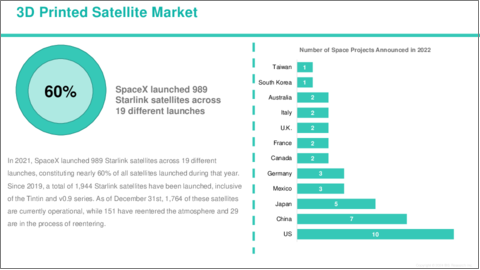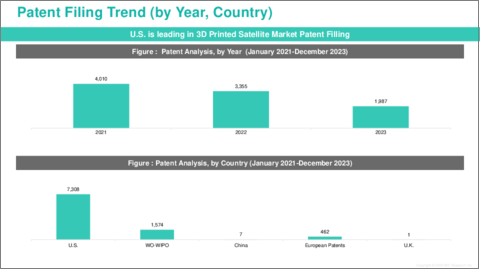|
|
市場調査レポート
商品コード
1489280
3Dプリント衛星市場 - 世界および地域の分析:コンポーネント・製造技術・衛星質量・用途・地域別の分析・予測 (2024-2034年)3D Printed Satellite Market - A Global and Regional Analysis: Focus on Component, Manufacturing Technique, Satellite Mass, Application, and Region - Analysis and Forecast, 2024-2034 |
||||||
カスタマイズ可能
|
|||||||
| 3Dプリント衛星市場 - 世界および地域の分析:コンポーネント・製造技術・衛星質量・用途・地域別の分析・予測 (2024-2034年) |
|
出版日: 2024年06月06日
発行: BIS Research
ページ情報: 英文 100 Pages
納期: 1~5営業日
|
全表示
- 概要
- 目次
3Dプリント衛星の市場は、付加製造技術の進歩やさまざまな分野での小型衛星ミッションの需要の増加を背景に、近年目覚ましい成長を遂げています。
楽観的シナリオで見ると、3Dプリント衛星の市場規模は、2024年の1億2,320万米ドルから、CAGR 24.60%で推移し、2034年には11億1,100万米ドルに達すると予測されています。
| 主要市場統計 | |
|---|---|
| 予測期間 | 2024-2034年 |
| 2024年評価 | 1億2,320万米ドル |
| 2034年予測 | 11億1,100万米ドル |
| CAGR | 24.6% |
複雑なコンポーネントを精密かつ効率的に製造できる3Dプリンティングは、衛星製造に革命をもたらし、納期の短縮とコスト効率の高い製造を可能にしました。この技術により、衛星メーカーは設計を迅速に反復し、特定のミッション要件に合わせてコンポーネントをカスタマイズし、従来の製造方法と比較して全体的な製造コストを削減することができます。さらに、3Dプリンティング技術へのアクセス性の向上と、宇宙用途に適した特殊材料の出現も市場の拡大にさらに拍車をかけています。通信、地球観測、ナビゲーションといった衛星ベースのサービスへの需要が高まり続ける中、3Dプリント衛星市場は持続的な成長を遂げる態勢を整えており、既存の航空宇宙企業と革新的な新興企業の双方に、この進化する情勢を活用し、宇宙産業のイノベーションを推進する機会を提供しています。
3Dプリント衛星市場における通信の重要性は、世界的な接続を促進する上で極めて重要な役割を果たすという点にあります。衛星は、従来の地上インフラが不足している遠隔地やアクセスしにくい地域で通信サービスを提供するために不可欠です。僻地におけるインターネットアクセス、通信、放送サービスを可能にする衛星通信の重要な機能により、通信目的に特化した3Dプリント衛星の需要が高まっています。
さらに、災害対応、軍事活動、科学研究など、さまざまな用途で衛星通信への依存が高まっていることも、通信に特化した3Dプリント衛星の市場成長をさらに加速させています。例えば、自然災害や緊急時には、地上のインフラが損なわれる可能性がありますが、衛星通信は接続を維持し、救助活動を調整する信頼できる手段として維持されます。これらの要因から、世界の接続性と通信インフラの重要性の高まりを反映して、通信が3Dプリント衛星市場の主要部門として際立っている理由は明確です。
当レポートでは、世界の3Dプリント衛星の市場を調査し、業界の動向、技術・特許の動向、法規制環境、使用事例、市場成長促進要因・抑制要因、市場規模の推移・予測、各種区分・地域/主要国別の詳細分析、競合情勢、主要企業のプロファイルなどをまとめています。
目次
エグゼクティブサマリー
第1章 市場:業界の展望
- 動向:現在および将来の影響評価
- サプライチェーンの概要
- バリューチェーン分析
- 価格予測
- R&Dレビュー
- 特許出願動向:国・年別
- 規制状況
- ステークホルダー分析
- 使用事例
- エンドユーザーと購入基準
- 主要な世界的イベントの影響分析
- 市場力学の概要
- 市場促進要因
- 市場抑制要因
- 市場機会
第2章 3Dプリント衛星市場:用途別
- 用途の分類
- 用途の概要
- 3Dプリント衛星市場:用途別
- 技術開発
- 通信
- ナビゲーション
- 地球観測・リモートセンシング
第3章 3Dプリント衛星市場:製品別
- 製品の分類
- 製品の概要
- 3Dプリント衛星市場:コンポーネント別
- アンテナ
- ブラケット
- シールド
- ハウジング
- 推進
- 3Dプリント衛星市場:製造技術別
- 熱溶解積層法 (FDM)
- 選択的レーザー焼結 (SLS)
- 電子ビーム溶解法 (EBM)
- 直接金属レーザー焼結 (DMLS)
- その他
- 3Dプリント衛星市場:衛星質量別
- ナノ&マイクロ衛星
- 小型衛星
- 中型・大型衛星
第4章 3Dプリント衛星市場:地域別
- 3Dプリント衛星市場:地域別
- 北米
- 欧州
- アジア太平洋
- その他の地域
第5章 企業プロファイル
- 次なるフロンティア
- 地理的評価
- Maxar Technologies
- Boeing
- 3D Systems, Inc.
- Northrop Grumman
- Fleetspace Technology Pty Ltd
- その他の主要企業
第6章 調査手法
Introduction to 3D Printed Satellite Market
The 3D printed satellite market has witnessed remarkable growth in recent years, driven by advancements in additive manufacturing technology and increasing demand for small satellite missions across various sectors. Considering the optimistic scenario the market is valued at $123.2 million in 2024 and is expected to grow at a CAGR of 24.60% to reach $1,111.0 million by 2034.
| KEY MARKET STATISTICS | |
|---|---|
| Forecast Period | 2024 - 2034 |
| 2024 Evaluation | $123.2 Million |
| 2034 Forecast | $1,111.0 Million |
| CAGR | 24.6% |
With the ability to produce complex components with precision and efficiency, 3D printing has revolutionized satellite manufacturing, enabling faster turnaround times and cost-effective production. This technology allows satellite manufacturers to iterate designs rapidly, customize components for specific mission requirements, and reduce overall production costs compared to traditional manufacturing methods. Moreover, the growing accessibility of 3D printing technology and the emergence of specialized materials suitable for space applications have further fueled market expansion. As the demand for satellite-based services such as communication, Earth observation, and navigation continues to rise, the 3D printed satellite market is poised for sustained growth, offering opportunities for both established aerospace companies and innovative startups to capitalize on this evolving landscape and drive innovation in the space industry.
The prominence of communication within the 3D printed satellite market can be understood through its pivotal role in facilitating global connectivity. Satellites are essential for providing communication services in remote or inaccessible areas where traditional terrestrial infrastructure is lacking. For instance, they enable internet access, telecommunications, and broadcasting services even in the most remote regions of the world. This critical function of satellite communication drives demand for 3D printed satellites tailored specifically for communication purposes.
Moreover, the increasing reliance on satellite communication for various applications, including disaster response, military operations, and scientific research, further amplifies the market growth for communication-focused 3D printed satellites. For instance, during natural disasters or emergencies, when ground infrastructure may be compromised, satellite communication remains a reliable means of maintaining connectivity and coordinating rescue efforts. Given these factors, it's evident why communication stands out as a leading segment within the 3D printed satellite market, reflecting the growing importance of global connectivity and communication infrastructure.
North America's leadership in the growth of the 3D printed satellite market can be attributed to several factors. Firstly, the region is home to a robust aerospace industry with a strong focus on innovation and technology development.
Additionally, North America boasts a supportive regulatory environment and significant investment in space research and development, fostering a conducive ecosystem for the adoption of 3D printing in satellite manufacturing. For instance, NASA has been actively exploring the use of 3D printing in space missions, collaborating with industry partners to advance additive manufacturing technologies for space applications. This combination of technological expertise, industry collaboration, and supportive policies positions North America as a key driver of market growth in the 3D printed satellite sector.
In the competitive landscape of the 3D printed satellite market, several key players are vying for market share by leveraging technological advancements and strategic partnerships. Established aerospace companies, such as SpaceX, Boeing, and Lockheed Martin, are at the forefront, driving innovation and setting industry standards in satellite manufacturing through their extensive expertise and resources. Additionally, a growing number of startups and specialized firms are entering the market, offering niche solutions and catering to specific segments within the satellite industry. As demand for 3D printed satellite solutions continues to rise, competition intensifies, prompting companies to focus on differentiation, cost-effectiveness, and reliability to gain a competitive edge in this dynamic market environment.
Market Segmentation:
Segmentation 1: by Application
- Technology Development
- Communication
- Navigation
- Earth Observation and Remote Sensing
Segmentation 2: by Component
- Antenna
- Bracket
- Shield
- Housing
- Propulsion
Segmentation 3: by Manufacturing Technique
- Fused Deposition Modelling (FDM)
- Selective Laser Sintering (SLS)
- Electron Beam Melting (EBM)
- Direct Metal Laser Sintering (DMLS)
- Others
Segmentation 4: by Satellite Mass
- Nano and Microsatellites
- Small Satellites
- Medium and Large Satellites
Segmentation 5: by Region
- North America
- Europe
- Asia-Pacific
- Rest-of-the-World
How can this report add value to an organization?
Product/Innovation Strategy: The global 3D printed satellite market has been extensively segmented based on various categories, such as application, component, manufacturing technique, and satellite mass. This can help readers get a clear overview of which segments account for the largest share and which ones are well-positioned to grow in the coming years.
Competitive Strategy: A detailed competitive benchmarking of the players operating in the global 3D printed satellite market has been done to help the reader understand how players stack against each other, presenting a clear market landscape. Additionally, comprehensive competitive strategies such as partnerships, agreements, and collaborations will aid the reader in understanding the untapped revenue pockets in the market.
Key Market Players and Competition Synopsis
The companies that are profiled have been selected based on thorough secondary research, which includes analyzing company coverage, product portfolio, market penetration, and insights gathered from primary experts.
Some of the prominent companies in this market are:
- Maxar Technologies
- Boeing
- 3D Systems, Inc.
- Northrop Grumman
- Fleetspace Technology Pty Ltd
Key Questions Answered in this Report:
- What are the main factors driving the demand for 3D printed satellite market?
- How many patents have been filed by the companies active in the 3D printed satellite market?
- Who are the key players in the 3D printed satellite market, and what are their respective market shares?
- What partnerships or collaborations are prominent among stakeholders in the 3D printed satellite market?
- What are the strategies adopted by the key companies to gain a competitive edge in 3D printed satellite market?
- What is the futuristic outlook for the 3D printed satellite market in terms of growth potential?
- What is the current estimation of the 3D printed satellite market and what growth trajectory is projected from 2024 to 2034?
- Which application, and product segment is expected to lead the market over the forecast period (2024-2034)?
- What could be the impact of growing application in the 3D printed satellite market?
- Which regions demonstrate the highest adoption rates for 3D printed satellite market, and what factors contribute to their leadership?
Table of Contents
Executive Summary
Scope and Definition
Market/Product Definition
Key Questions Answered
Analysis and Forecast Note
1. Markets: Industry Outlook
- 1.1 Trends: Current and Future Impact Assessment
- 1.2 Supply Chain Overview
- 1.2.1 Value Chain Analysis
- 1.2.2 Pricing Forecast
- 1.3 R&D Review
- 1.3.1 Patent Filing Trend by Year, by Country
- 1.4 Regulatory Landscape
- 1.5 Stakeholder Analysis
- 1.5.1 Use Case
- 1.5.2 End User and Buying Criteria
- 1.6 Impact Analysis for Key Global Events
- 1.7 Market Dynamics Overview
- 1.7.1 Market Drivers
- 1.7.2 Market Restraints
- 1.7.3 Market Opportunities
2. 3D Printed Satellite Market (by Application)
- 2.1 Application Segmentation
- 2.2 Application Summary
- 2.3 3D Printed Satellite Market (by Application)
- 2.3.1 Technology Development
- 2.3.2 Communication
- 2.3.3 Navigation
- 2.3.4 Earth Observation and Remote Sensing
3. 3D Printed Satellite Market (by Products)
- 3.1 Product Segmentation
- 3.2 Product Summary
- 3.3 3D Printed Satellite Market (by Component)
- 3.3.1 Antenna
- 3.3.2 Bracket
- 3.3.3 Shield
- 3.3.4 Housing
- 3.3.5 Propulsion
- 3.4 3D Printed Satellite Market (by Manufacturing Technique)
- 3.4.1 Fused Deposition Modelling (FDM)
- 3.4.2 Selective Laser Sintering (SLS)
- 3.4.3 Electron Beam Melting (EBM)
- 3.4.4 Direct Metal Laser Sintering (DMLS)
- 3.4.5 Others
- 3.5 3D Printed Satellite Market (by Satellite Mass)
- 3.5.1 Nano and Microsatellites
- 3.5.2 Small Satellites
- 3.5.3 Medium and Large Satellites
4. 3D Printed Satellite Market (by Region)
- 4.1 3D Printed Satellite Market (by Region)
- 4.2 North America
- 4.2.1 Regional Overview
- 4.2.2 Driving Factors for Market Growth
- 4.2.3 Factors Challenging the Market
- 4.2.4 Application
- 4.2.5 Product
- 4.2.6 U.S.
- 4.2.6.1 Market by Application
- 4.2.6.2 Market by Product
- 4.2.7 Canada
- 4.2.7.1 Market by Application
- 4.2.7.2 Market by Product
- 4.2.8 Mexico
- 4.2.8.1 Market by Application
- 4.2.8.2 Market by Product
- 4.3 Europe
- 4.3.1 Regional Overview
- 4.3.2 Driving Factors for Market Growth
- 4.3.3 Factors Challenging the Market
- 4.3.4 Application
- 4.3.5 Product
- 4.3.6 Germany
- 4.3.6.1 Market by Application
- 4.3.6.2 Market by Product
- 4.3.7 France
- 4.3.7.1 Market by Application
- 4.3.7.2 Market by Product
- 4.3.8 U.K.
- 4.3.8.1 Market by Application
- 4.3.8.2 Market by Product
- 4.3.9 Italy
- 4.3.9.1 Market by Application
- 4.3.9.2 Market by Product
- 4.3.10 Rest-of-Europe
- 4.3.10.1 Market by Application
- 4.3.10.2 Market by Product
- 4.4 Asia-Pacific
- 4.4.1 Regional Overview
- 4.4.2 Driving Factors for Market Growth
- 4.4.3 Factors Challenging the Market
- 4.4.4 Application
- 4.4.5 Product
- 4.4.6 China
- 4.4.6.1 Market by Application
- 4.4.6.2 Market by Product
- 4.4.7 Japan
- 4.4.7.1 Market by Application
- 4.4.7.2 Market by Product
- 4.4.8 India
- 4.4.8.1 Market by Application
- 4.4.8.2 Market by Product
- 4.4.9 Australia
- 4.4.9.1 Market by Application
- 4.4.9.2 Market by Product
- 4.4.10 Rest-of-Asia-Pacific
- 4.4.10.1 Market by Application
- 4.4.10.2 Market by Product
- 4.5 Rest-of-the-World
- 4.5.1 Regional Overview
- 4.5.2 Driving Factors for Market Growth
- 4.5.3 Factors Challenging the Market
- 4.5.4 Application
- 4.5.5 Product
- 4.5.6 South America
- 4.5.6.1 Market by Application
- 4.5.6.2 Market by Product
- 4.5.7 Middle East and Africa
- 4.5.7.1 Market by Application
- 4.5.7.2 Market by Product
5. Companies Profiled
- 5.1 Next Frontiers
- 5.2 Geographic Assessment
- 5.2.1 Maxar Technologies
- 5.2.1.1 Overview
- 5.2.1.2 Top Products/Product Portfolio
- 5.2.1.3 Top Competitors
- 5.2.1.4 Target Customers
- 5.2.1.5 Key Personnel
- 5.2.1.6 Analyst View
- 5.2.1.7 Market Share
- 5.2.2 Boeing
- 5.2.2.1 Overview
- 5.2.2.2 Top Products/Product Portfolio
- 5.2.2.3 Top Competitors
- 5.2.2.4 Target Customers
- 5.2.2.5 Key Personnel
- 5.2.2.6 Analyst View
- 5.2.2.7 Market Share
- 5.2.3 3D Systems, Inc.
- 5.2.3.1 Overview
- 5.2.3.2 Top Products/Product Portfolio
- 5.2.3.3 Top Competitors
- 5.2.3.4 Target Customers
- 5.2.3.5 Key Personnel
- 5.2.3.6 Analyst View
- 5.2.3.7 Market Share
- 5.2.4 Northrop Grumman
- 5.2.4.1 Overview
- 5.2.4.2 Top Products/Product Portfolio
- 5.2.4.3 Top Competitors
- 5.2.4.4 Target Customers
- 5.2.4.5 Key Personnel
- 5.2.4.6 Analyst View
- 5.2.4.7 Market Share
- 5.2.5 Fleetspace Technology Pty Ltd
- 5.2.5.1 Overview
- 5.2.5.2 Top Products/Product Portfolio
- 5.2.5.3 Top Competitors
- 5.2.5.4 Target Customers
- 5.2.5.5 Key Personnel
- 5.2.5.6 Analyst View
- 5.2.5.7 Market Share
- 5.2.6 Other Key Players
- 5.2.1 Maxar Technologies





